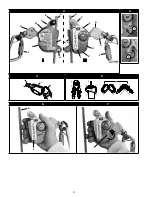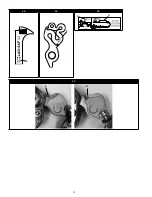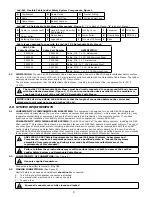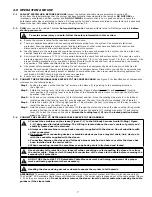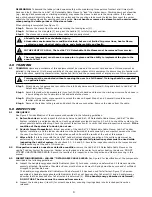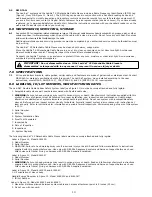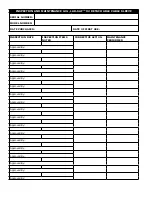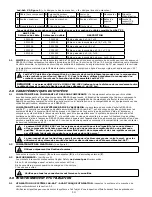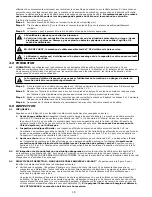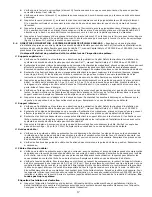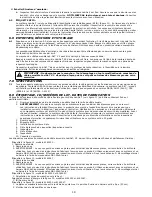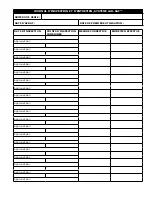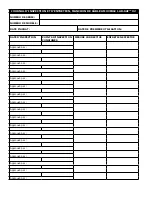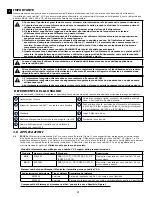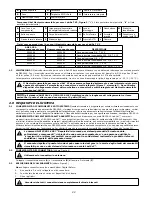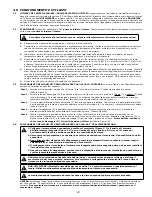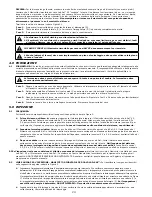
9
•
Inspect the cam (item L) for wear. Confirm that there is no damage to the cam.
•
Inspect cam (item L) by holding the sleeve vertically with the handle/energy absorber (item D) in the upright position
and shaking the sleeve up and down to simulate a fall. The cam should rotate freely.
•
Inspect cam (item L) by positioning the sleeve horizontally with the handle/energy absorber (item D) in the upright
position and placing the sleeve on the back side on a flat surface with the Lad-Saf X2 label facing up. The cam should
rotate fully upwards to the top of the sleeve.
•
Inspect the operation of the rotating side plate (item C) by pulling it back to try to open the cable slot. It must not
rotate. If it does rotate without having to rotate the locking lever (Figure 2, item G), remove the sleeve from service.
5.4
INSPECTION GUIDELINES - LAD-SAF
™
LADDER SAFETY SYSTEM:
Refer to the Installation Instructions supplied
with your Lad-Saf Flexible Cable Ladder Safety System (Lad-Saf™ Flexible Cable Ladder Safety Systems Installation
Instructions, Capital Safety manual #5902228 or #5903435.) when performing the inspection procedures described in
this section.
A separate fall protection system must be used during the System Inspection.
;
Top Brackets:
•
Inspect for proper installation per Capital Safety Lad-Saf™ Flexible Cable Ladder Safety Systems Installation
Instructions, Capital Safety manual #5902228 or #5903435.
•
Check for visible damage or corrosion. Look for cracks, bends or wear that could affect the strength and operation
of the system. Inspect welds. Look for cracked or broken welds that could affect strength of bracket. Replace parts if
defects are found.
•
Check for loose or missing fasteners that secure top bracket to structure (bolts, clamp plates, U bolts). If fasteners
are loose, re-tighten as necessary to the torque levels listed in the Installation Instructions supplied with your Lad-Saf
Flexible Cable Ladder Safety System.
•
Inspect carrier clamps (some models will contain a swaged on carrier lug in place of the carrier clamp). Cable should
extend above carrier clamp 1.0 inch (2.5 cm) to 2.0 inch (5.0 cm). Adjust cable if amount of cable extension is
outside of described range. Steel washer should be present between carrier clamp and shock absorber.
•
Look down the inside of the pipe and inspect the shock absorber for damage such as cracks or splits. The bottom of
the shock absorber should project out the bottom hole in the top bracket pipe. Replace the shock absorber if defects
are found.
•
Inspect the cap that fits on the top of the pipe. Check for cracks or damage to the cap. The cap should fit securely
onto the pipe. Replace if defects are found.
;
Bottom Bracket:
•
Inspect for proper installation per Capital Safety Lad-Saf™ Flexible Cable Ladder Safety Systems Installation
Instructions, Capital Safety manual #5902228 or #5903435.
•
Check for damage or corrosion. Look for cracks, bends or wear that could affect the strength and operation of the
system. Replace parts if defects are found.
•
Check for loose or missing fasteners that secure bottom bracket to the structure. If fasteners are loose, re-tighten as
necessary to the torque levels listed in the Installation Instructions supplied with your Lad-Saf Flexible Cable Ladder
Safety System.
•
Inspect the tension rod assembly. Make certain saddle clips securely retain the cable. Check torque on saddle clamps
– 35 ft. lbs. (47 N-m). Replace or retighten if defects are found.
;
Cable Guides:
•
Check cable guides for damage. Look for wear or damage to black urethane. Cable guides should restrain the cable
and prevent cable contact with the ladder/structure. Cable guides should be placed approximately every 25 ft (8 m)
or closer if required. Replace parts if defects are found.
•
Check cable guide fasteners. The fasteners should the secure cable guide in position. Tighten as necessary.
;
Cable and Cable Tension:
•
Inspect the cable for corrosion, kinks or damage that will affect strength and impede the cable sleeve from traveling
on the cable. If there are any nicks or kinks in the ladder cable, the cable must be inspected by a competent person
prior to use. Inspect for signs of abrasion against the ladder or structure. Replace the cable if defects are found.
•
Inspect the cable tension. For systems that utilize a compression spring, the spring in the bottom bracket should be
compressed to 5-1/2 inch (13.8 cm) length. For systems that utilize a tension rod and tension indicator washer, the
washer should be indicated (center ridge sheared off) and the washer imbedded fully into hole of bottom bracket. You
should not be able to pull tension rod down by hand. Cable should be tight enough to prevent contact with the ladder/
structure. Re-tension the cable if necessary. For bottom brackets that contain an indicating washer, a new washer
(part no. 9504239) should be installed if the cable is re-tensioned. Tighten the system until indicating washer ring is
sheared off.
Do not over-tension the system.
;
Installation and Service Label:
•
Inspect the installation and service label. The label should be securely attached and fully legible. The installation date
and number of users allowed on the system should be clearly marked on the label. Record the inspection date on the
label after this inspection is completed.
;
Ladder/Climbing Structure:
•
Inspect the ladder/climbing structure to which the Lad-Saf
™
system is attached. Make sure the structure is in good
condition, secure, and safe to climb.
DO NOT USE if the condition of the structure is questionable.
Consult
instructions and/or personnel familiar with the structure prior to use.


